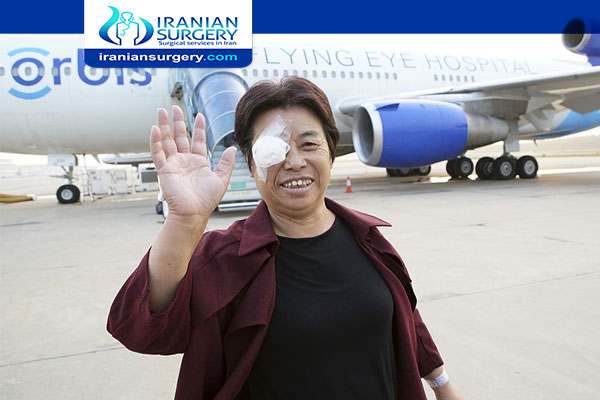What can you not do after a corneal transplant?
How long should one wait to fly after a corneal transplant?
During a corneal transplant an ophthalmologist places an air bubble into the eye to help the graft (donor eye tissue) adhere to the inner surface of the cornea. While this air bubble is in place, it is very dangerous to fly as the bubble can expand at higher altitudes. Depending on how much air is inserted, it may take between two days and two weeks for the bubble to reabsorb. Without question, you should not fly for any reason until your ophthalmologist has confirmed that the air bubble has dissipated.
Read more about : Total knee replacement surgery success story in Iran
Read more about : Kidney transplant in Iran success story in Iran
After Corneal Transplant
What should I expect after my cornea transplant?
For the first few days after surgery, expect your eye to be red, irritated, and sensitive to light. Typically, pain can be controlled with over-the-counter pain relievers that your surgeon can recommend.
Your eye will be covered with an eye patch after your surgery. The eye patch must be worn when you shower and sleep. Your surgeon will also talk about activities you will need to avoid, especially any activities that could result in a direct hit to your eye. For endothelial transplants, you will need to position with your face up (on your back) for a few days after surgery.
You will have a follow-up visit with your surgeon, usually within 24 to 48 hours of your surgery. He or she will remove your eye patch and check on how well your eye is healing. Also, eye drops and ointments will be prescribed to help your eye heal. Eye drops and ointments usually prescribed are both antibiotics (to prevent infection) and corticosteroids (to reduce swelling, inflammation, and to prevent rejection).
Stitches may need to be removed depending on the type of stitches and surgical technique used. If stitches do need to be removed, they may not be removed for several months.
Your surgeon will recommend that you wear glasses or other protective eyewear for a period of time to help protect your eyes. While recovering, you should not rub or press on your eyes. Rubbing can cause damage and interfere with healing.
Read more about : Corneal transplant recovery
Once your cornea transplant is completed, you can expect to:
. Receive several medications. Eyedrops and, sometimes, oral medications immediately after cornea transplant and during recovery will help control infection, swelling and pain.
. Wear an eye patch. An eye patch may protect your eye as it heals after your surgery.
. Protect your eye from injury. Plan to take it easy after your cornea transplant, and slowly work your way up to your normal activities, including exercise. For the rest of your life, you'll need to take extra precautions to avoid harming your eye.
. Return for frequent follow-up exams. Expect frequent eye exams in which your doctor looks for complications in the first year after surgery.
What is the prognosis (outlook) for people who have a cornea transplant?
The degree of long-term success depends on a number of factors including the underlying cause of the cornea damage, surgical technique used, expertise of the surgeon, patient’s immune system acceptance of the donor transplant (organ rejection) and other factors. Because the rates vary so greatly, you should ask your doctor about the rate of success in your eye. It is important to keep in mind that vision is usually blurred after surgery and will gradually improve over time. The length of time it takes to return to good vision depends on several factors, including the type of surgery performed. It may take up to 12 months for full vision to be achieved in patients who undergo full thickness tissue transplant. For endothelial transplants (DMEK and DSAEK), good vision is typically achieved within 3 months.
Will I need to wear glasses or contacts after cornea transplant?
An irregular cornea surface is expected following full thickness corneal transplant surgery. This imperfection in the curve of the cornea, called astigmatism, results in distorted vision. Correction with glasses, contact lenses, or additional surgery is often needed. Special types of contact lenses (rigid gas permeable or scleral lenses [a larger lens that lays on the white part of the eye]) are not typically needed following endothelial transplants, but may be needed after penetrating keratoplasty or deep anterior lamellar keratoplasty surgery. Your surgeon will discuss the best options to meet your vision needs.
How soon can I drive after a cornea transplant?
You must not drive on the day of your cornea transplant. Someone must drive you home after surgery and bring you back for your follow-up visit.
If you have good vision in the non-transplant eye, you can legally drive 24 hours after surgery. However, your surgeon may recommend waiting longer before driving.
When can I return to work after a cornea transplant?
It may take a few days to a few weeks before you can return to work. It depends on your level of discomfort, your vision and what activities you perform at work. Jobs that require strenuous activity such as lifting may need more time off from work.
When should I call my surgeon?
Contact your surgeon immediately if you experience any signs of cornea rejection, including:
. Eye pain
. Eye redness
. Hazy or cloudy vision
. Sensitivity to light



1 Comment
What a material of un-ambiguity and preserveness of precious know-how on the topic
of unexpected emotions.